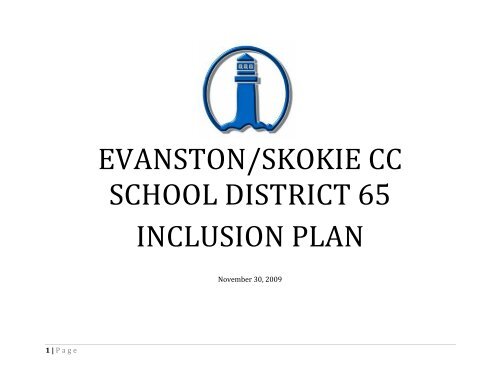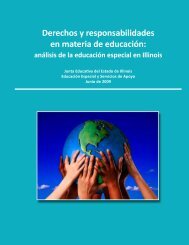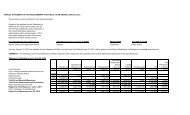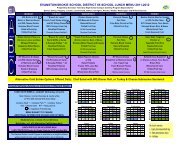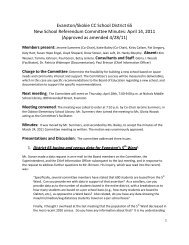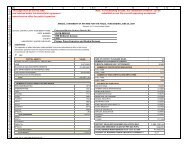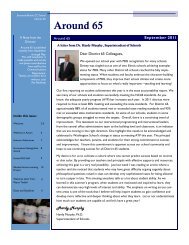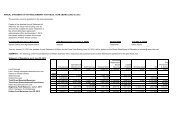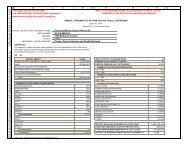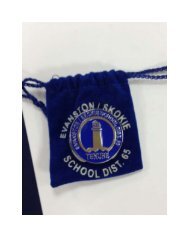EVANSTON/SKOKIE CC SCHOOL DISTRICT 65 INCLUSION PLAN
EVANSTON/SKOKIE CC SCHOOL DISTRICT 65 INCLUSION PLAN
EVANSTON/SKOKIE CC SCHOOL DISTRICT 65 INCLUSION PLAN
Create successful ePaper yourself
Turn your PDF publications into a flip-book with our unique Google optimized e-Paper software.
<strong>EVANSTON</strong>/<strong>SKOKIE</strong> <strong>CC</strong><strong>SCHOOL</strong> <strong>DISTRICT</strong> <strong>65</strong><strong>INCLUSION</strong> <strong>PLAN</strong>November 30, 20091 | P age
Special thanks to the participating members of the focus groups and to the following members of the District <strong>65</strong> districtwideplanning team:Hardy Murphy, Ph.D., Superintendent of SchoolsMargie Lenoir‐Davis, Interim Director of Special ServicesJames McHolland, PrincipalWille Shaw, TeacherCecelia Wallin, ParentSiobhan Donati, TeacherKathy Lyons, ParentDonna Sokolowski, TeacherStephanie Reynolds, TeacherCynthia Rolfe, ParentMichael Dougherty, PrincipalMarlene Grossman, PrincipalMarie Chang Pisano, TeacherLinda Olivera, Building CoachJean Luft, District Educators Council (DEC) PresidentCari Levin, ParentSusan Schultz, Assistant SuperintendentMichael Robey, Assistant SuperintendentEllen Fogelberg, Literacy and Early Childhood EducationDirectorPat Markham, Communications DirectorLinda Fowlkes, Special Education SupervisorPatti Seifer, Early ChildhoodKathy Roberson, PrincipalTracy Quattrocki, School Board MemberAndrew Krugly, PrincipalPatrice Prescott, TeacherKelly Rooney, TeacherDavid Davis, TeacherGloria Iverson, TeacherHeather Shaffer, TeacherJulie De Lara, ParentSarah Hering, ParaprofessionalFacilitators:Sandi Cole, Ed.D., Director – Center on Education and Lifelong Learning – Indiana UniversityCheryl Crosby, Project CHOICES2 | P age
District <strong>65</strong> Inclusion PlanInclusion embodies the values, policies, and practices that support the right of every student and his/her family, regardless ofability, to participate in a broad range of activities and contexts as full members of families, communities and society. The desiredresults of inclusive experiences for students with and without disabilities and their families include a sense of belonging andmembership, positive social relationships and friendships, and development and learning to reach their full potential.District Strategic PlanCore Values:Excellence in education and high expectations for all students in all schools.Neighborhood schools that support families and communities.A welcoming, orderly and inclusive environment that respects individual differences.The role of parents and guardians as partners in the education of their children.The cognitive, emotional, physical, social and creative development of all students.The treatment of every individual in an open, equitable, fair and professional manner.Guiding Principles for Inclusion1. All students with disabilities have a right to be included in naturally occurring settings and activities with theirneighborhood peers, siblings, and friends.2. All students will be given the opportunity for meaningful participation and engagement in the general educationcurriculum and in their school community.3. Communities of support will be nurtured where differences are acknowledged, understood, accepted and celebrated.4. A spirit of collaboration, active participation and support among families, administration and staff is valued andfostered.5. A continuum of services and supports should reflect intensity of supports and not a separate place.3 | P age
Goals and Action Items:Goal1. Families will bepartners in theeducation of theirchildren.Strategy1.1 Develop collaborative relationships with outside agencies providing services to D<strong>65</strong> students.1.2 Identify a district liaison/outreach person for inclusion.1.3 Host a “meet and greet” for special services staff and families.1.4 Establish a buddy system/mentor program for parents.1.5 Create a 1‐page parent friendly special education “Welcome to the team” document.1.6 Create an Individual Education Plan at a glance.1.7 Provide multiple means of communication for parents.1.8 Develop procedures to ensure that information regarding their child’s program will be made availablebefore school begins.1.9 Develop a parent network and support for parents of students with disabilities.1.10 Use PTA forums to educate community on child development issues.1.11 Provide parent education and information regarding inclusion at all schools prior to the start of school.1.12 Develop an “inclusion fair” or ways to celebrate inclusion.4 | P age
Goal2. Students withdisabilities will beeducated inintegrated ageappropriateenvironments thatfully support theirsocial, emotional,physical andacademic needs.Strategy2.1 Review inclusion for Park School and include Park students in implementation timeline.2.2 Increase co‐teaching classrooms throughout the district.2.3 Provide collaboration time for staff to effectively meet student needs.2.4 Integrate related services with less pull out.2.5 Utilize technology to include students in the classroom.2.6 Encourage special education teachers to sponsor extra‐curricular activities.2.7 Assign all students with disabilities to a general education classroom.2.8 Continue the acceleration of Tier 2 and Tier 3 Positive Behavior Intervention Supports (PBIS) trainingand services.2.9 Develop Individual Education Plan’s to support inclusive practices.2.10 Provide appropriate modifications and accommodations for all students.5 | P age
Goal3. D<strong>65</strong> willconsistentlycommunicate, andeducate individualschool communitiesand the broaderschool communityregarding inclusion.Strategy3.1 Provide opportunities for teachers and administrators to observe other districts who have implementedinclusion.3.2 Share video from planning session (“Disability is Natural”) and other videos with staff and parents.3.3 Provide time for staff to be educated on inclusion and engage them in discussions.3.4 Develop “Inclusion on a page” to communicate this plan to parents and the community.3.5 Ensure that both teachers’ names appear on assignment notices in co‐taught classrooms.3.6 Develop strategies in all buildings to move toward the goals of this plan.3.7 Highlight successes of the plan in monthly newsletters.3.8 Provide parent forums to answer question regarding inclusion plan.3.9 Provide information and partner with outside organizations (e.g. YMCA, Northwestern, City Parks andRec.)3.10 Create partnerships with community centers to offer increased accessibility to educational opportunities.3.11 Hold information meetings on inclusion plan.3.12 Have parent advisory develop a plan for parent education.3.13 Develop a DVD to communicate this plan in a consistent manner and program on local station.3.14 Address inclusion in beginning of school letters.3.15 Provide information on inclusion at curriculum nights.3.16 Provide ongoing consultation and support with individual schools throughout the year to brainstorm andproblem solve.3.17 Communicate with private placement sites and other out of district programs about the D<strong>65</strong> plan.6 | P age
Goal4. A seamless systemof education that isunified acrossgeneral and specialeducation will beimplementeddistrict‐wide.Strategy4.1 Maintain administrative structure that eliminates separation between special education and generaleducation.4.2 Increase co‐taught classrooms.4.3 Hire new staff with qualifications and experience in inclusion and/or dual license in bi‐lingual/special andgeneral education.4.4 Support current staff to pursue dual license.4.5 Develop an administrative structure chart with roles and responsibilities.4.6 Define and communicate a consistent Response to Intervention (RTI) plan.4.7 Address inclusion in opening day.4.8 Provide education and training to principals regarding inclusion.4.9 Develop a cohesive plan that integrates district initiatives and which connect the various initiatives.4.10 Provide teacher materials to all teachers.4.11 Examine and better define the role of special education supervisors.4.12 Develop procedures to ensure that information regarding student Individual Education Plan’s is sharedwith all service providers.4.13 Develop procedures to ensure that information on student’s Individual Education Plan is shared withteachers and service providers before the school year begins.7 | P age
Goal5. Priority will begiven to maximizecontinuity of servicesand supports toallow families tohave stability inschool placement.Strategy5.1 Identify high service delivery buildings in each middle school cluster.5.2 Gather baseline data to identify students by level of service need and where they live.5.3 Consider students with disabilities as an “at risk” population to recognize the profoundly negative impactdisruption has for them.5.4 Build capacity to support students with intensive needs in each middle school cluster.5.5 Develop a long‐range sustainable plan to ensure continuity of services.5.6 Consider all options when conditions change.8 | P age
Goals6. Social inclusionpractices are in placein all schools.Strategy6.1 Create differentiated supports during unstructured time.6.2 Plan field trips, school events and opportunities outside of academics with the needs of all students inmind and provide necessary accommodations and adaptations.6.3 Highlight/spotlight disability issues through speakers and community productions.6.4 Investigate lunch buddies, peer tutors, recess mentoring and/or other ways that students can support oneanother.6.5 Foster empathy, understanding and knowledge of students with disabilities through modeling, coachingand literature.6.6 Provide disability awareness training and resources for all D<strong>65</strong> students, families and staff.6.7 Include all students in performances.6.8 Celebrate positive deeds/actions.6.9 Broaden current definition of verbal abuse in discipline code to include derogatory terms related todisability.6.10 Encourage school‐wide projects to support inclusion.9 | P age
Goal7. Planned, relevant,differentiated andon‐goingprofessionaldevelopment will berequired for all staff.Strategy7.1 Provide opportunities for peer observations within the district.7.2 Provide opportunities for staff to visit exemplary inclusion sites in other districts and provide discussionand de‐briefing after visit.7.3 Partner with universities to provide on‐site courses to get teachers dually licensed.7.4 Develop a professional development plan and communicate in a timely way.7.4.1 Menu of workshops7.4.2 Indicate required and optional choices7.4.3 Provide summer training options with incentives for teachers7.5 Create structures at the building level to allow teachers to de‐brief and plan for co‐teaching anddifferentiated instruction.7.6 Train and utilize coaches to support teachers.7.7 Provide education, training, coaching and mentoring for principals on inclusion.7.8 Continue to provide outside consultant to help inclusion leaders (e.g. principals’, administration) to learnand problem solve.7.9 Provide specific building based training to support teachers in developing accommodations for specificstudents.7.10 Use staff meetings and development days to bring teachers together to network, plan and debrief.7.11 Provide professional development for teacher assistants and support staff.7.12 Provide more intensive training for co‐teaching.7.13 Continue to provide coaching and training on differentiated instruction.7.14 Provide Positive Behavior Intervention Supports re‐training.10 | P age
Goal8. Instructionalpractices will be inplace in allclassrooms to ensureaccess to the districtcurriculum.Strategy8.1 Provide differentiated teaching materials for all classrooms.8.2 Ensure that both special and general education teachers have district curriculum materials.8.3 Ensure that all staff has training in Positive Behavior Intervention Supports and differentiated instruction.8.4 Ensure that new assistive technologies are tried and applied when necessary to ensure all students haveaccess to the curriculum.8.5 Conduct an assistive technology evaluation to review district practices and recommend improvements.8.6 Continue to expand the use of differentiated instruction.8.7 Ensure that effective progress monitoring is implemented throughout the district.8.8 Incorporate inclusion‐sensitivity training in Positive Behavior Intervention Supports “Cool Tools”.8.9 Review Positive Behavior Intervention Supports structure and ensure its is implemented in the way it isintended—move from extrinsic rewards to intrinsic rewards.8.10 Design and implement effective interventions throughout the district.11 | P age
Goals9. A comprehensivesystem with multiplemeasures of successwill be used toevaluate theinclusion initiative.Strategy9.1 Use a measurement rubric of staff beliefs and attitudes toward inclusion.9.2 Observe co‐teaching practices across the district to ensure effective implementation.9.3 Increase discussion in Individual Education Plan meetings regarding inclusive options for students.9.4 Conduct regular observation/walk throughs.9.5 Include all stakeholders in evaluation and honor all feedback.9.6 Increase initiatives to address the over‐representation of “speech only” Individual Education Plan’s.9.7 Conduct an annual parent/guardian, staff and student survey.9.8 Gather district data to show more students are spending more time in the general education environment.9.9 Use existing tools (Project Choices, Indiana University) to assess the progress of the district’simplementation of inclusion.9.10 Use multiple measures of student achievement outcomes.9.11 Gather qualitative data from teachers who are implementing inclusion.9.12 Increase alternative to suspension placements and alternatives to placements outside of district.9.13 Use measures to determine student social/emotional well being.9.14 Increase involvement of students with disabilities in extra‐curricular activities.9.15 Gather qualitative data from parents.9.16 Gather anecdotal data from Individual Education Plan team members regarding student’s increasedinteraction with peers.9.17 Gather data about the roles and responsibilities of psychologists and social workers.12 | P age
Goal10. All students willhave improvedstudent outcomesacademically, sociallyand emotionally.Strategy10.1 Increase number of students with Individual Education Plan’s meeting standards as measured by stateand district assessments.10.2 Use existing Positive Behavior Intervention Support rating scales to measure students with disabilities.10.3 Gather longitudinal data to track exiting high school students with disabilities with respect to academicachievement and post‐secondary plans /outcomes.10.4 Disaggregate data to determine relationship between inclusion and student/family demographics, e.g.race, language, poverty etc.10.5 Establish academic, social and emotional baseline data.13 | P age
Definitions:Meaningful Participation. The mere presence of students with learning disabilities in general education classrooms is notinclusion. Inclusion involves meaningful participation by these students, achievement in accordance with their abilities, andsocial acceptance by teachers and peers. Inclusion has to mean that all students are a part of what is going on in the classroom(Weiner, J., 2009)Naturally Occurring Settings Refers to serving children with disabilities in the same settings designed for children withoutdisabilities. Inclusion is more than merely integrating children with disabilities into the same physical space as their nondisabledclassmates. To be fully included, children with disabilities have opportunities to interact with other children andparticipate in the same activities as their typically developing peers. Being taught in the natural environment or normalroutines in everyday environments that their peers are involved in.Outside agencies: Any community agency that is involved in providing support to individual students or a school.Coteaching:Two or more professionals: At least two appropriately licensed professionals; co‐teachers are peers that have equivalentcredentials and employment status and can truly be partners in the classroom on behalf of all students.Jointly delivering substantive instruction: Both teachers have active roles in teaching and jointly share in the decision‐makingabout instruction.To a diverse, or blended, group of students: The diverse group of students includes students with disabilities and other diversegroups to ensure a heterogeneous classroom. Diversity should not inadvertently result in a disproportionate number ofstudents with disabilities in any one classroom.14 | P age
In a single physical space: Though one teacher may occasionally take a small, group of students to a separate location for aspecific instructional purpose and for a limited time period, the co‐teaching should occur in a single physical environment thatis shared by two teachers. (Friend, M. and Cook, L. 2003)The intensity may vary: for example, teachers may co‐teach for a small instructional block of time for a specific curricular unit;teachers may co‐teach 3 out of 5 days of the week; teachers may co‐teach for a half day every day, or a full day every day. Thisis only one of many ways to provide support to the classroom.Modifications: Usually a modification means a change in what is being taught or expected from the student. Making anassignment easier so the student is not doing the same level of work as other students is an example of a modification. Amodification may change instructional level, content or performance level.Accomodations: An accommodation is a change in how a student accesses or demonstrates learning. Allowing a student whohas trouble writing to give his answers orally is an example of an accommodation. This student is still expected to know thesame material and answer the same questions as fully as the other students, but he doesn’t have to write his answers to showthat he knows the information. An accommodation does not substantially change instructional level, content or performancelevel.Differentiated Instruction: involves providing students with different avenues to acquiring content; to processing,constructing, or making sense of ideas; and to developing teaching products so that all students within a classroom can learneffectively, regardless of differences in ability (Tomlinson, 2000). Differentiated instruction, according to Carol Ann Tomlinson(as cited by Ellis, Gable, Greg, & Rock, 2008, p. 32), is the process of “ensuring that what a student learns, how he/she learns it,and how the student demonstrates what he/she has learned is a match for that student’s readiness level, interests, andpreferred mode of learning”. Differentiation stems from beliefs about differences among learners, how they learn, learningpreferences and individual interests (Anderson, 2007).Individual Education Plan: commonly referred to as an IEP. It is mandated by the Individuals with Disabilities EducationAct (IDEA). The IDEA requires public schools to develop an IEP for every student with a disability who is found to meet thefederal and state requirements for special education. The IEP must be designed to provide the child with a Free Appropriate15 | P age
Public Education (FAPE). The IEP refers both to the educational program to be provided to a child with a disability and to thewritten document that describes that educational program. Key considerations in developing an IEP include assessingstudents in all areas related to the suspected disability(ies), considering access to the general curriculum, considering how thedisability affects the student’s learning, developing goals and objectives that make the biggest difference for the student, andultimately choosing a placement in the least restrictive environment.Positive Behavior Interventions and Supports (PBIS): a decision making framework that guides selection, integration, andimplementation of the best evidence‐based academic and behavioral practices for improving important academic andbehavior outcomes for all students. In general, PBIS emphasizes four integrated elements: (a) data for decision making, (b)measurable outcomes supported and evaluated by data, (c) practices with evidence that these outcomes are achievable, and(d) systems that efficiently and effective support implementation of these practices.Response to Intervention (RTI): Response To Intervention a method of academic intervention designed to provide early,effective assistance to children who are having difficulty learning. Response to intervention was also designed to function as adata‐based process of diagnosing learning disabilities. This method can be used at the group and individual level. The RTImethod has been developed by researchers as an alternative to identifying learning disabilities with the ability‐achievementdiscrepancy model, which requires children to exhibit a severe discrepancy between their IQ and academic achievement asmeasured by standardized tests. (Haager, D. et al , 2007). RTI seeks to prevent academic failure through early intervention,frequent progress measurement, and increasingly intensive research‐based instructional interventions for children whocontinue to have difficulty (Cortiella, C., 2007).High Service Delivery Buildings: Schools that house a large population of students with disabilities.16 | P age


